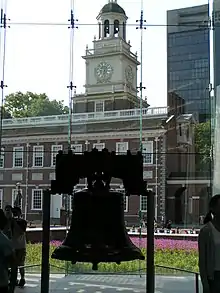Norristown, Pennsylvania
Norristown is a municipality with home rule status and the county seat of Montgomery County, Pennsylvania, United States, in the Philadelphia metropolitan area.[3] Located along the Schuylkill River, approximately 6 miles (9.7 km) from Philadelphia, Norristown had a population of 35,748 as of the 2020. It is the fourth-most populous municipality in the county and second-most populous borough in Pennsylvania.[4]
Norristown | |
|---|---|
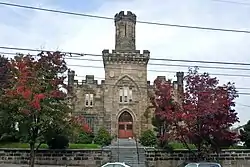 Central Norristown Historic District in November 2011 | |
 Flag 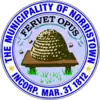 Seal | |
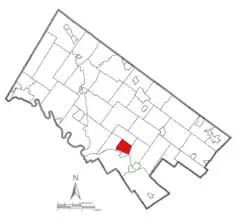 Location of Norristown in Montgomery County, Pennsylvania | |
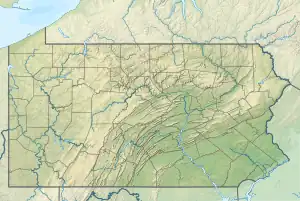 Norristown Location of Norristown in Pennsylvania  Norristown Norristown (the United States) | |
| Coordinates: 40°07′12″N 75°20′30″W | |
| Country | United States |
| State | Pennsylvania |
| County | Montgomery |
| Settled | 1682 |
| Borough | 1812 |
| Municipality | 1986 |
| Government | |
| • Type | Council–manager |
| Area | |
| • Total | 3.60 sq mi (9.33 km2) |
| • Land | 3.52 sq mi (9.10 km2) |
| • Water | 0.09 sq mi (0.23 km2) |
| Elevation | 135 ft (41 m) |
| Population | |
| • Total | 35,748 |
| • Density | 10,170.13/sq mi (3,926.44/km2) |
| Demonym | Norristonians |
| Time zone | UTC-5 (EST) |
| • Summer (DST) | UTC-4 (EDT) |
| ZIP Codes | 19401, 19403-19409, 19487-19489 |
| Area codes | 610 and 484 |
| FIPS code | 42-54656 |
| Website | www |
It is the largest non-township municipality in Montgomery County and is located 49.8 miles (80.1 km) southeast of Allentown and 19.9 miles (32.0 km) northwest of Philadelphia, the sixth-largest city in the United States.
History
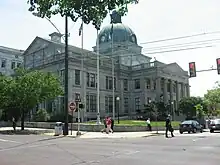
Present-day Norristown was originally owned by the family of Isaac Norris. Along with William Trent, Norris purchased the land on October 7, 1704, for 50¢ per acre. In 1712, Norris acquired Trent's share and established a gristmill at the foot of present-day Water Street.[5]
Named the county seat in 1784 when Montgomery County was formed, Norristown was incorporated as a borough in 1812 and subsequently enlarged in 1853. About 500 people lived there at the time of its incorporation. Growing rapidly after the Civil War, it swelled to 22,265 people by 1900. By 1940 it was home to 38,181 Norristonians, making it the most populous borough in Pennsylvania before declining in the decades after World War II, and in fact it was described in that year as "the most populous independent borough in the United States."[5]
At its height, Norristown was an industrial, retail, banking, and government center. Breweries, cigar factories, textile mills, icehouses, foundries, rolling mills, and lumber yards provided ample employment for skilled laborers and artisans.[6] The downtown featured two department stores, several theaters, and enough goods and services that residents never had to leave town to find anything they needed.[7] Although primarily settled by the English and a handful of Germans, Scots, Dutch, and Swedes, in the mid-1800s the Irish began arriving in large numbers, followed by waves of Italians at the turn of the century.[8]
With the opening of new malls in nearby King of Prussia and Plymouth Meeting, the downtown declined in the decades after World War II. Industry soon followed, as many companies closed or relocated into new industrial parks throughout Montgomery County.[9]
Geography
Norristown is located in southeastern Pennsylvania, approximately 6 mi (10 km) northwest of Philadelphia, although direct driving distance from downtown Norristown to Center City Philadelphia is about 17 mi (27 km). Totaling 3.519 square miles in land area, the municipality sits along the Schuylkill River. Two major tributaries, the Stony Creek and the Saw Mill Run, bisect the town into thirds and empty directly into the Schuylkill. The town's terrain is generally hilly, especially in the areas closest to downtown, which itself sits on a plateau surrounded by all three major waterways.
Norristown has four distinct neighborhoods: the West End, the East End, the North End, and the downtown.
It is bounded by West Norriton, East Norriton, and Plymouth townships, as well as the borough of Bridgeport.
Climate
In the Köppen climate classification, the borough has a humid subtropical climate (Cfa) according to recent temperature numbers. The Trewartha climate classification now has the climate as Do (oceanic because only seven months are above 50 °F.) The hardiness zone is 7a.
| Climate data for Norristown, Pennsylvania (1991–2020 normals, extremes 1951–present) | |||||||||||||
|---|---|---|---|---|---|---|---|---|---|---|---|---|---|
| Month | Jan | Feb | Mar | Apr | May | Jun | Jul | Aug | Sep | Oct | Nov | Dec | Year |
| Record high °F (°C) | 76 (24) |
78 (26) |
84 (29) |
98 (37) |
98 (37) |
100 (38) |
108 (42) |
106 (41) |
102 (39) |
92 (33) |
85 (29) |
76 (24) |
108 (42) |
| Average high °F (°C) | 41.7 (5.4) |
43.5 (6.4) |
52.1 (11.2) |
64.8 (18.2) |
74.8 (23.8) |
84.0 (28.9) |
88.8 (31.6) |
86.5 (30.3) |
80.0 (26.7) |
68.4 (20.2) |
56.8 (13.8) |
46.3 (7.9) |
65.6 (18.7) |
| Daily mean °F (°C) | 32.1 (0.1) |
34.1 (1.2) |
41.8 (5.4) |
53.1 (11.7) |
63.4 (17.4) |
73.0 (22.8) |
77.7 (25.4) |
75.9 (24.4) |
68.8 (20.4) |
56.5 (13.6) |
45.9 (7.7) |
37.3 (2.9) |
55.0 (12.8) |
| Average low °F (°C) | 22.6 (−5.2) |
24.7 (−4.1) |
31.6 (−0.2) |
41.5 (5.3) |
52.1 (11.2) |
62.0 (16.7) |
66.6 (19.2) |
65.2 (18.4) |
57.6 (14.2) |
44.6 (7.0) |
35.1 (1.7) |
28.3 (−2.1) |
44.3 (6.8) |
| Record low °F (°C) | −12 (−24) |
−5 (−21) |
8 (−13) |
15 (−9) |
29 (−2) |
41 (5) |
48 (9) |
40 (4) |
35 (2) |
26 (−3) |
14 (−10) |
−10 (−23) |
−12 (−24) |
| Average precipitation inches (mm) | 3.66 (93) |
2.98 (76) |
4.41 (112) |
3.90 (99) |
4.25 (108) |
4.20 (107) |
4.70 (119) |
4.98 (126) |
4.91 (125) |
4.32 (110) |
3.61 (92) |
4.73 (120) |
50.65 (1,287) |
| Average snowfall inches (cm) | 6.8 (17) |
10.9 (28) |
3.0 (7.6) |
0.2 (0.51) |
0.0 (0.0) |
0.0 (0.0) |
0.0 (0.0) |
0.0 (0.0) |
0.0 (0.0) |
0.1 (0.25) |
0.1 (0.25) |
4.2 (11) |
25.3 (64) |
| Average precipitation days (≥ 0.01 in) | 11.0 | 9.4 | 11.1 | 12.8 | 14.1 | 11.9 | 10.7 | 10.4 | 8.9 | 11.2 | 9.3 | 10.5 | 131.3 |
| Average snowy days (≥ 0.1 in) | 3.3 | 2.9 | 1.6 | 0.1 | 0.0 | 0.0 | 0.0 | 0.0 | 0.0 | 0.1 | 0.1 | 1.4 | 9.5 |
| Source: NOAA[10][11] | |||||||||||||
Demographics
| Census | Pop. | Note | %± |
|---|---|---|---|
| 1820 | 827 | — | |
| 1830 | 1,089 | 31.7% | |
| 1840 | 2,937 | 169.7% | |
| 1850 | 6,024 | 105.1% | |
| 1860 | 8,848 | 46.9% | |
| 1870 | 10,753 | 21.5% | |
| 1880 | 13,063 | 21.5% | |
| 1890 | 19,791 | 51.5% | |
| 1900 | 22,265 | 12.5% | |
| 1910 | 27,875 | 25.2% | |
| 1920 | 32,319 | 15.9% | |
| 1930 | 35,853 | 10.9% | |
| 1940 | 38,181 | 6.5% | |
| 1950 | 38,126 | −0.1% | |
| 1960 | 38,925 | 2.1% | |
| 1970 | 38,169 | −1.9% | |
| 1980 | 34,684 | −9.1% | |
| 1990 | 30,749 | −11.3% | |
| 2000 | 31,282 | 1.7% | |
| 2010 | 34,324 | 9.7% | |
| 2020 | 35,748 | 4.1% | |
| Sources:[12][13][14][15][16][2] | |||
As of 2019, Norristown's population is 34,341, which represents a 0% increase since 2010. The municipality's population is 37.2% black or African American, 27.9% white (non-Hispanic), 27.1% Hispanic and two or more races 6.4%.
There were 11,963 households and 7,498 families residing in the municipality.[17] The population density was 9,753.9 people per square mile. There were 13,420 housing units at an average density of 3,813.5 per square mile.[18]
Of the 11,963 households, 62.7% (7,498) were family households and 37.3% were non-family households. Of the 7,498 families, 58.2% had their own and related children under the age of 18 living with them; 51.0% were married couples living together, and 36.6% had a female householder with no husband present. The average household size was 2.79 and the average family size was 3.41.[19]
The median age of all residents is 31.2 years, with an age distribution of 26.2% under the age of 18, 43.5% between ages 18 and 44, 21.2% between ages 45 and 64, and 9.1% ages 65 and above.[20]
According to the U.S. Census Bureau's 2012 American Community Survey, the median household income was $42,764. Males had a median income of $34,214 versus $34,086 for females. The per capita income was $21,204. About 17.3% of families and 19.3% of the population were below the poverty line, including 28.3% of those under the age of 18 and 11.8% of those 65 and older.[19]
Approximately 76.0% of all persons 25 and older have a high school diploma or higher, while 16.7% have a college degree (Bachelor's or higher).[21]
Economy
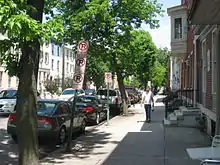
Norristown's economy is based largely on institutions in the government, healthcare, legal, and social services sectors. The Montgomery County government is the municipality's largest employer.[22] Major Norristown employers include the Pennsylvania Department of Environmental Protection (DEP), the Montgomery County Intermediate Unit, the Norristown Area School District, and others.
Politics and government
| Year | Republican | Democratic |
|---|---|---|
| 2020 | 17.8% 2,099 | 81.4% 9,600 |
| 2016 | 17.1% 1,891 | 79.7% 8,826 |
| 2012 | 16.0% 1,749 | 83.0% 9,053 |
| 2008 | 17.0% 2,042 | 82.3% 9,911 |
| 2004 | 24.2% 2,611 | 75.3% 8,147 |
| 2000 | 24.6% 2,066 | 73.0% 6,124 |
Norristown has been a home rule municipality since 1986 when voters adopted a charter with a manager/council form of government and a seven-member municipal council. The office of mayor was abolished in July 2004 after a public referendum amended the municipal charter. Executive and administrative authority is now delegated to a council appointed Municipal Manager.
The municipality is part of the Fifth Congressional District (represented by Rep. Mary Gay Scanlon), the 70th State House Districts (represented by Rep. Matt Bradford) and the 17th State Senate District (represented by Sen. Amanda Cappelletti).
Infrastructure
Transportation
_from_the_overpass_for_the_Schuylkill_River_Trail_in_Norristown%252C_Montgomery_County%252C_Pennsylvania.jpg.webp)
As of 2015 there were 56.07 miles (90.24 km) of public roads in Norristown, of which 3.81 miles (6.13 km) were maintained by the Pennsylvania Department of Transportation (PennDOT) and 52.26 miles (84.10 km) were maintained by the borough.[24]
Norristown sits near the junction of several major roads in the Philadelphia metropolitan area. Main Street, also known as Ridge Pike, outside of the municipality, and Airy Street run east–west through the downtown, eventually leading to interchanges for I-476 (the Blue Route) and the Pennsylvania Turnpike (I-276), respectively, in Plymouth Meeting. US 202 is the major north–south route through the town, connecting it with other nearby county seats such as Doylestown and West Chester. US 202 is split into a one-way pair through the municipality, as DeKalb Street is designated “US 202 North” while Markley Street is signed “US 202 South.”[25][26]
Norristown is the largest multi-modal transportation hub in Montgomery County. Numerous rail lines, bus routes, multi-use trails, and parking areas converge at the Norristown Transportation Center (NTC). SEPTA operates eight Suburban Division bus routes (90, 91, 93, 96, 97, 98, 99, and 131), one interurban rapid transit route, the Norristown High Speed Line to 69th Street Transportation Center, and a Regional Rail line (the Manayunk/Norristown Line to Center City Philadelphia) out of the NTC complex.
The Regional Rail station at the Norristown Transportation Center is one of three on the Manayunk/Norristown Line in Norristown. The other two are Main Street and Elm Street, the latter of which serves as the terminus of the line.
The NTC contains a 522-space SEPTA commuter parking garage that also contains an intercity bus terminal that was formerly used by Bieber Transportation Group, Greyhound Lines, and Martz Trailways.[27] Several taxi companies and private bus shuttles have a presence at the Transportation Center. The Schuylkill River Trail, which connects Philadelphia to Pottstown and runs through downtown Norristown, also passes through the NTC complex. The Chester Valley Trail will also connect to the Transportation Center in the future.
Utilities
Electricity and natural gas in Norristown is provided by PECO Energy Company, a subsidiary of Exelon.[28][29][30] Water is provided by Pennsylvania American Water, a subsidiary of American Water.[31] The Norristown Municipal Waste Authority provides sewer service, operating collection sewers and a wastewater treatment plant.[32] Trash and recycling collection is provided under contract by J.P. Mascaro.[33]
Media
The Times Herald is the borough's daily newspaper, printing seven days a week and serving most of Montgomery County. Founded on June 15, 1799, it is currently owned by 21st Century Media.[34] The paper's staff offices are located within the municipality.
Culture
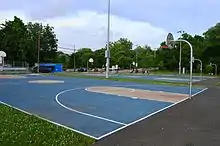
Despite the loss of its historic movie and vaudeville theaters, Norristown is home to two performing arts centers, the Montgomery County Cultural Center and Centre Theatre, and one professional theater company, Theatre Horizon. All are part of The Theatre Alliance of Greater Philadelphia and the Greater Philadelphia Cultural Alliance.
These theaters form the nucleus for Norristown Arts Hill, a collection of theaters, art galleries, and professional firms on the 300-500 blocks of DeKalb Street in downtown.
Revitalization
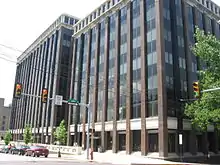
Norristown has seen several new office buildings constructed or rehabbed over the last several decades. One Montgomery Plaza, the municipality's iconic downtown 10-story office building, was built in the early 1970s, and is now owned by Montgomery County. Two newer mid-rise downtown office buildings, the Montgomery County Intermediate Unit Building and the Department of Environmental Protection Building, were built in the 1990s and early 2000s. In 2009, the historic former Bell Telephone building was completely renovated for offices, and that same year the U.S. Roofing Corporation rehabbed the former Conte Luna pasta factory on East Main Street to house their operations. The former Sears building at the Studio Centre shopping center in the North End was renovated as a modern office center.
Since the early 2000s, Regatta Apartments, the Rittenhouse condominium building, the Luxor, and dozens of new townhouses have contributed to a residential boom in the East End.
Two new downtown parking garages were built in the late 2000s, one at Main and Cherry Streets for visitors and another at SEPTA’s Norristown Transportation Center on Lafayette Street. Several large downtown and neighborhood streetscape projects were completed by the municipal government to install new street lighting, trees, curbing, and sidewalks along Main Street, DeKalb Street, and Powell Street.
The Lafayette Street Extension Project, a $60 million effort by Montgomery County, PennDOT, and the Federal Highway Administration (FHWA), is now open to traffic. It has improved highway access and mobility into downtown Norristown by widening Lafayette Street and extending it eastward toward Ridge Pike and Conshohocken, with eventual connections to the Pennsylvania Turnpike (I-276) and the US 202 Dannehower Bridge.[35]
Education
Norristown Area School District is the local school district.
St. Francis of Assisi School is located in Norristown.[36]
Other area Catholic schools include Visitation B.V.M. School in West Norriton Township,[37] near the Trooper census-designated place and near Norristown;[38] Holy Rosary Regional Catholic School in Plymouth Meeting and Plymouth Township; and Mother Teresa Regional Catholic School in King of Prussia. Holy Rosary was formed in 2012 by the merger of St. Titus School in East Norriton, Epiphany of Our Lord School in Plymouth Meeting, and Our Lady of Victory in East Norriton. Mother Teresa formed in 2012 by the merger of St. Teresa of Avila in West Norriton and Mother of Divine Providence in King of Prussia.[37][39] Both St. Titus and St. Teresa had Norristown, Pennsylvania postal addresses but were not in the city proper.[40]
Notable locations
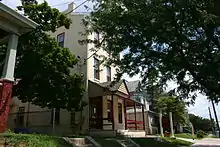
Notable people
- Nia Ali, track & field olympian
- Geno Auriemma, Hall of Fame women's basketball coach at UConn
- Jan Backus, politician
- Maria Bello, actress (ER, A History of Violence)
- Steve Bono, former NFL quarterback
- Peter Boyle, actor (Everybody Loves Raymond, Young Frankenstein)
- Harry Roberts Carson, Episcopal Bishop of Haiti
- Josh Culbreath, athlete (1957 400 m hurdles world record), actor
- Richard Derr, actor
- David C. Dolby, Medal of Honor
- Werner Erhard, founder of Erhard Seminars Training (EST)
- Jules Fisher, lighting designer
- Joseph Fornance, U.S. Congressman and Norristown Borough council president.
- Larry Glueck, football player for Villanova and 1963 NFL champion Chicago Bears, head coach for Fordham University
- Marques Green, basketball player
- Winfield Scott Hancock, field commander at Gettysburg, presidential candidate
- John F. Hartranft, Governor of Pennsylvania 1873–1879
- Soh Jaipil, first Korean to become a naturalized citizen of the United States
- Gertrude I. Johnson (1876—1961), co-founder of Johnson & Wales University, born and died in Norristown[41]
- Maud Coan Josaphare (1886-1935), arts educator and writer
- Tommy Lasorda, manager of Los Angeles Dodgers, Baseball Hall of Famer
- Drew Lewis, CEO Union Pacific, U.S. Secretary of Transportation
- Eugene Lewis, Canadian Football League wide receiver
- Thaddeus Lowe, Civil War-era aeronaut, scientist, and inventor
- Bobby Mitchell, professional baseball player
- William Moore, U.S. Congressman representing New Jersey 1869–1871
- Timothy L. O'Brien, journalist
- Jaco Pastorius, bass guitarist, musician
- John Pergine, NFL linebacker
- Mike Piazza, professional baseball player, Baseball Hall of Fame catcher of the New York Mets
- George Bryan Porter, Territorial Governor of Michigan[42]
- David Rittenhouse Porter, Governor of Pennsylvania 1839–1845
- Jack Posobiec, political operative, conspiracy theorist
- Catherine Pugh, 50th Mayor of Baltimore[43]
- Martha Settle Putney, educator and historian
- Brothers Quay (Stephen and Timothy), stop-motion animators
- Lisa Raymond, WTA tennis player
- Cam Reddish, Former Duke basketball player, current NBA player for the New York Knicks
- Bill Schonely, broadcaster
- Richard Schweiker, U.S. Senator from Pennsylvania, Secretary of Health and Human Services
- Jimmy Smith, jazz musician
- Art Spiegelman, cartoonist, Maus
- Jerry Spinelli, author
- Kellee Stewart, actress
- Ralph B. Strassburger, newspaper publisher, thoroughbred racehorse owner
- John F. Street, Mayor of Philadelphia 2000–2008
- Roy Thomas, Philadelphia Phillies outfielder 1899-1908 and University of Pennsylvania head baseball coach
- Christian Walker, professional baseball player, Arizona Diamondbacks first baseman 2017-present
- Bobby Wine, professional baseball player, coach, manager and scout
- Khalif Wyatt (born 1991), basketball player for Hapoel Holon of the Israeli Basketball Premier League[44]
In popular culture
- Maniac Magee, author Jerry Spinelli based the fictional town of Two Mills on Norristown, where he was born.[45]
- The X-Files, Season 4, Episode 10 ("Paper Hearts") mentions Norristown
- The Lovely Bones
- The Devil in the White City
See also
References
- "ArcGIS REST Services Directory". United States Census Bureau. Retrieved October 12, 2022.
- "Census Population API". United States Census Bureau. Retrieved October 12, 2022.
- "Find a County". National Association of Counties. Retrieved June 7, 2011.
- Demographic and Information Packet, Montgomery County Planning Commission (MCPC), http://webapp.montcopa.org/planning/dataportal/pdfs/2012demogentiredocument.pdf, page 8.
- Federal Writers' Project (1940). Pennsylvania: A Guide to the Keystone State (1st ed.). New York: Oxford University Press. p. 427.
- Montgomery County Federation of Historical Societies, Montgomery County: The Second Hundred Years; Toll, Jean Barth and Michael J. Schwager, ed.;1983, pg. 464
- Barth and Schwager, pg.463
- Barth and Schwager, pg. 469
- Barth and Schwager, pg. 465
- "NowData – NOAA Online Weather Data". National Oceanic and Atmospheric Administration. Retrieved August 9, 2021.
- "Station: Norristown, PA". U.S. Climate Normals 2020: U.S. Monthly Climate Normals (1991-2020). National Oceanic and Atmospheric Administration. Retrieved August 9, 2021.
- "Number of Inhabitants: Pennsylvania" (PDF). 18th Census of the United States. U.S. Census Bureau. Retrieved November 22, 2013.
- "Pennsylvania: Population and Housing Unit Counts" (PDF). U.S. Census Bureau. Retrieved November 22, 2013.
- "U.S. Census website". United States Census Bureau. Retrieved January 31, 2008.
- "Incorporated Places and Minor Civil Divisions Datasets: Subcounty Population Estimates: April 1, 2010 to July 1, 2012". U.S. Census Bureau. Archived from the original on June 11, 2013. Retrieved November 25, 2013.
- "Census 2020".
- MCPC, pg. 15
- MCPC, pg. 14
- Bureau, U. S. Census. "U.S. Census website". United States Census Bureau. Retrieved April 2, 2019.
- MCPC, pg. 10
- MCPC, pg. 16
- PA Department of Labor and Industry, "Archived copy". Archived from the original on March 16, 2015. Retrieved July 7, 2015.
{{cite web}}: CS1 maint: archived copy as title (link). - "Montgomery County Election Results". Montgomery County, Pennsylvania. Retrieved January 16, 2017.
- "Norristown Borough map" (PDF). PennDOT. Retrieved March 10, 2023.
- Montgomery County, Pennsylvania (Map) (18th ed.). 1"=2000'. ADC Map. 2006. ISBN 0-87530-775-2.
- Google (September 22, 2014). "overview of Norristown, Pennsylvania" (Map). Google Maps. Google. Retrieved September 22, 2014.
- "Philadelphia Schedule Update". Martz Group. May 29, 2018. Retrieved September 11, 2019.
- "PECO: Company Information". PECO Energy Company. Retrieved January 29, 2017.
- "Electric Service Tariff" (PDF). PECO Energy Company. July 17, 2017. p. 4. Retrieved October 10, 2017.
- "Gas Service Tariff" (PDF). PECO Energy Company. August 30, 2017. p. 2. Retrieved October 10, 2017.
- "Rates, Rules and Regulations Governing the Distribution and Sale of Water Service" (PDF). Pennsylvania American Water. August 8, 2018. p. 11. Retrieved September 9, 2018.
- "News & Events / About Us". Norristown Municipal Waste Authority. Archived from the original on January 14, 2014. Retrieved July 31, 2023.
- "Trash". Municipality of Norristown. Retrieved July 31, 2023.
- 21st Century Media list of brands and products, "Products | Digital First Media". Archived from the original on September 20, 2014. Retrieved September 20, 2014.
- Montgomery County Planning Commission, Lafayette Street Extension Project website, http://www.lafayettestreetproject.com.
- "Home". St. Francis of Assisi School. Retrieved May 2, 2020.
- "Zoning Map". West Norriton Township. Retrieved May 2, 2020. - Church and school locations for St. Teresa of Avila and Visitation BVM indicated on the map
- "Home". West Norriton Township, Montgomery County, Pennsylvania: Visitation BVM School. Retrieved May 3, 2020.
Visitation BVM School - 190 N. Trooper Road, Trooper, PA 19403
- The archdiocese states the address as Archived September 25, 2021, at the Wayback Machine: "190 North Trooper Rd. Norristown PA, 19403" - The school is both outside of the Trooper CDP limits and outside of the Norristown city limits. - "2012 Catholic grade school consolidations/closings". Catholicphilly.com. July 15, 2012. Retrieved April 22, 2020.
- "St. Titus". Roman Catholic Archdiocese of Philadelphia. January 13, 1998. Archived from the original on January 13, 1998. Retrieved May 2, 2020.
3006 Keenwood Rd. 19403
- Compare with the East Norriton zoning map for proof of location: "Zoning Map" (PDF). East Norriton Township. Retrieved May 2, 2020. - DeSimone, Russell (2015). "Gertrude I. Johnson". Rhode Island Heritage Hall of Fame. Retrieved January 1, 2018.
- "George Bryan Porter". 2010 by the Litchfield Historical Society. Retrieved June 9, 2014.
- "Who is Catherine Pugh?". WMAR. December 6, 2016.
- "Khalif Wyatt Stats, News, Bio". ESPN.
- Long Bostrom, Kathleen (June 2003). Winning Authors: Profiles of the Newbery Medalists. Libraries Unlimited. pp. 247–251. ISBN 1-56308-877-0.
Further reading
- Kerkstra, Patrick (November 25, 2003). "Mexican immigrants boost a growing Latino population". The Philadelphia Inquirer. Archived from the original on December 5, 2003. Retrieved December 16, 2019.
- O'Toole, Stephen (December 30, 2002). "Norristown ready to recognize Mexican IDs". The Times Herald (Norristown, Pennsylvania).
- Heysham, Theodore (1913). Norristown, 1812-1912. Norristown.
{{cite book}}: CS1 maint: location missing publisher (link)

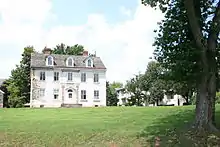
.jpg.webp)

